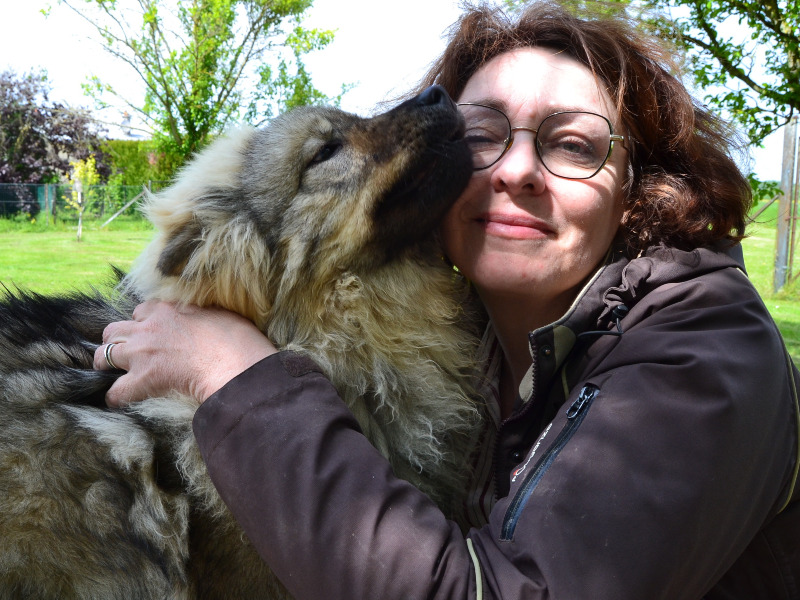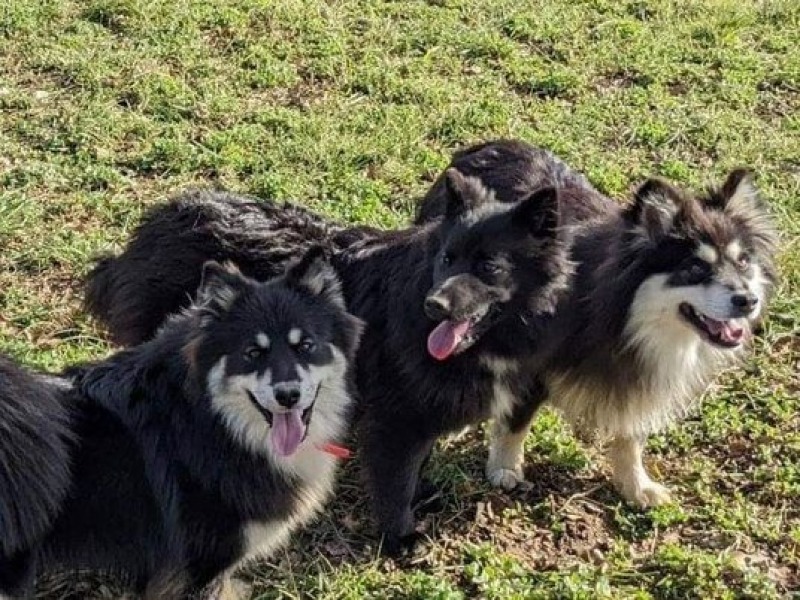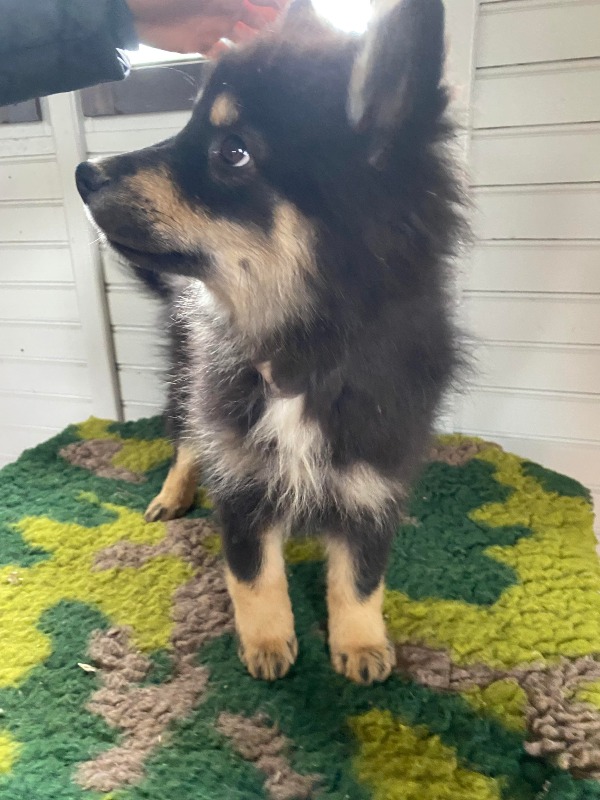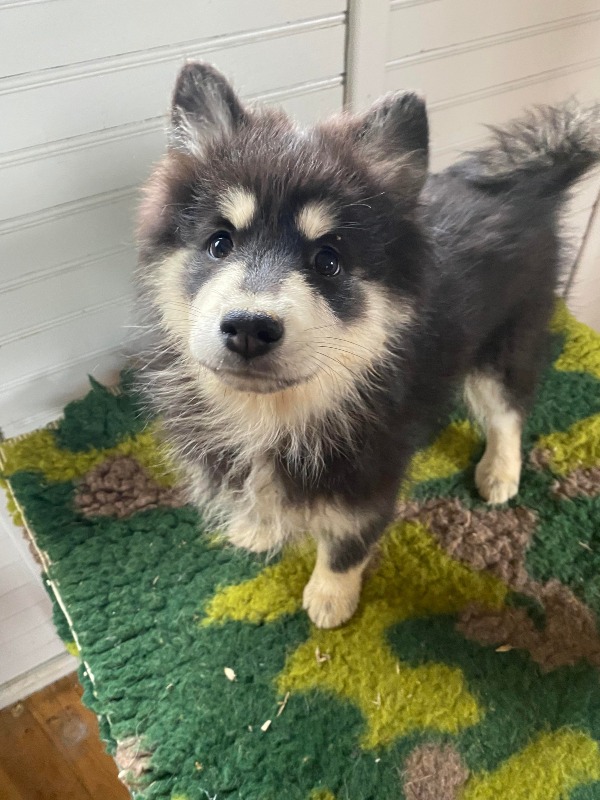Finnish lapphund
Welcome to our page dedicated to the breed of dog finnish lapphund!
Here, you will find all the useful information about finnish lapphund. This descriptive profile will allow you to discover the aspects of this breed. You can notably consult information about the average price, monthly and annual upkeep expenses, their health, name ideas, as well as their official recognition by competent authorities.
Explore this page to discover everything you need to know.
Overall description of the breed
The Finnish Lapphund has been used for centuries by the Lappish people to herd and guard reindeer. Its morphological type was not well established before the 20th century, so its first standard was set in 1945 by the Finnish Kennel Club. After the war, a great deal of selection work was carried out by serious breeders, in order to develop rigorous programmes with the aim of creating a versatile working dog, particularly resistant to extreme weather conditions.
From the 1970's onwards, he changed names several times, but in 1993 the Finnish club decided to give him the name of Finnish Lapphund. Very popular in Northern Europe, especially in Finland, they are noted for their obedience and loyalty. His sociable and hard-working spirit made him a true national symbol of canine loyalty. In the meantime, the breed was finally registered by the international cynological federation on 22 August 1955 and its current standard was updated on 30 September 2016.
The Suomenlapinkoira, as it was originally called, is a medium-sized, rather high-legged dog with straight legs. They are light and agile in appearance, yet have a robust build and natural flexibility. Tough and remarkably resilient, his physical abilities are exceptional. His body is rectangular in shape, as his length slightly exceeds his height at the withers.
Its harmonious structure balances its silhouette, it has a wide chest, well sprung ribs as well as a short, straight and muscular back line. The head is round, broad, slightly convex, with a discreetly rounded forehead, the muzzle is of moderate length, with a clearly marked stop. Its triangular ears are of medium size, carried erect or semi-erect, they are set fairly far apart, always very mobile. The tail is set rather high, of medium length, the tip of the tail may have a J-shaped hook. The hair of the Lapphund is long, hard, particularly abundant in males, most of them sporting an opulent mane. The undercoat is well furnished, close and soft in texture. All colours are permitted by the breed standard.
The Lapphund is sociable, active and cheerful by nature, close to its social group as well as to other animals, with whom it can cohabit without any problem. Like most Spitz-type dogs, he will always attach himself to a particular person and be loyal to him until the end. He is an intelligent, docile dog who will enjoy playing or sporting with his family or other dogs. The Lapinkoira will need to spend time every day to feel completely fulfilled, truly inexhaustible, it is an animal that will always prefer wide open spaces and the open air, moreover, it will show little comfort in an urban environment.
The predatory instinct may appear in some specimens, but this trait can be quickly erased with a strict and positive education. The Finnish Hound is a pleasant family dog, which will prove to be a good guardian if it senses that a situation is abnormal, its natural mistrust of strangers reinforcing its protective side. Like all primitive dogs, he retains an independent and observant temperament, but his love for his loved ones will drive him to join them as soon as he gets the chance, to show them that even from afar he is watching over them!
Adult: The Suomenlapinkoira will weigh approximately 44lb and will stand 18"- 20.5" for males and 15.8"- 18.1" for females at the withers.
Awareness of acquiring an animal
Each animal is a sensitive being, deserving love, attention and care.
When you choose to adopt an animal, you take on the responsibility of ensuring its health and well-being throughout its life.
To learn more about animal welfare, we invite you to consult our FAQ by clicking the button below:
Origins
The Finnish Lapphund, also known as the Finnish Lapphund, originates from the Arctic regions of Scandinavia. Bred by the Sami people, an indigenous people, for guarding reindeer herds, this breed is deeply rooted in Sami culture. Its name reflects its heritage, as Lapland is the historical name of the region. These dogs were traditionally used to help nomads gather reindeer in the vast expanses of the tundra, which shaped their resilient nature and ability to adapt to the harshest climates.
History
The history of the Finnish Lapphund dates back to centuries, rooted in the pastoral tradition of the Sami people. These dogs were crucial for the economy of this community, helping in the management of reindeer. With the industrialization and modernization of northern Europe in the 20th century, the need for these working dogs decreased. However, enthusiasts have preserved the breed to maintain its rich history. Today, the Finnish Lapphund is recognized for its affectionate temperament and loyalty, although it is less common outside of its original lands.
Standard
The Finnish Lapphund standard highlights a robust and vigorous appearance. Its size varies from 43 to 49 cm for males and from 38 to 44 cm for females. Its coat is double and dense, with a thick undercoat to protect it from the cold. The colors of the coat range from black to brown, often with lighter markings. Its head bears a distinctive mask, and its ears are erect or semi-erect, giving it a lively and intelligent expression. Its tail is often carried in an arch, adding to its proud appearance.
Physical characteristics
The Finnish Lapphund is of medium size, with males measuring between 43 and 49 cm and females between 38 and 44 cm. Its double coat is thick, with a dense undercoat to resist cold climates. Colors range from black to brown, with various shades. The light facial markings around the eyes and muzzle give this breed a bright and intelligent look. Its curled tail often rests on its back, reflecting its energetic and alert nature.
Character
Known for their kindness and docile nature, Finnish Lapphunds are extremely loyal to their family. They are often reserved with strangers, making them good guard dogs. Their intelligence and eagerness to learn make them excellent companions for families. Although they are energetic, they adapt well to apartment living if given regular activity. Their friendly nature makes them particularly well-suited to households with children and other animals.
Life expectancy
The Finnish Lapphund has a life expectancy of about 12 to 15 years, which is typical of medium-sized dogs. With good nutrition, exercise, and regular veterinary care, these robust dogs can enjoy a long and healthy life. Their overall health is generally good, but they may be prone to certain hereditary conditions, making regular veterinary checks essential for early problem detection.
Exercise and activity needs
The Finnish Lapphund's diet must be balanced and adapted to its size, age, and activity level. High-quality food, rich in proteins and healthy fats, is essential to maintain its vitality. Monthly cost of its food can vary between 40 and 80 euros, depending on the chosen brands and the dog's specific needs. Treats should be given in moderation to avoid overweight, and constant access to fresh water is essential.
Recommended diet
To maintain their optimal health, it is recommended to feed the Finnish Lapphund with a high-quality diet, tailored to their age, weight, and activity level. The monthly cost of their food typically ranges between 40 and 60 euros, depending on the type of food and brand.
Training and obedience
The Finnish Lapphund is intelligent and responsive, making it easy to train. However, its independent nature requires a firm and consistent approach. Using positive reinforcement techniques, such as rewards and praise, is most effective. Early socialization is essential to teach them how to behave well with other dogs and humans. Due to their working dog heritage, they excel in activities such as agility and obedience.
Behavior with children
The Finnish Lapphund is naturally affectionate and protective towards children, making it an excellent companion for families. Its gentle and patient nature allows it to tolerate the sometimes unpredictable behavior of young children. However, as with any dog, it is essential to teach children to interact respectfully with the animal. Proper supervision and socialization ensure that the dog and children interact safely.
Compatibility with Other Animals
This breed generally gets along well with other pets, especially if they are raised together. However, their herding instinct may result in chasing behavior towards small animals. Early socialization and gradual introduction are essential to ensure peaceful cohabitation. Although their territorial instinct may make initial interactions challenging, they often end up accepting other animals once they understand the rules of the house.
Grooming needs
The dense coat of the Finnish Lapphund requires regular brushing to prevent knots and remove dead hair. During the shedding season, daily brushing is recommended to manage hair loss. Bathing should be limited to preserve the natural oils in its coat. Regular cleaning of ears, nail trimming, and oral hygiene are also important to maintain the overall health of the dog.
Health
The Finnish Lapphund is generally healthy, but like all breeds, it can be prone to certain genetic conditions. Hip dysplasia and patellar luxation are the most common orthopedic problems. Eye diseases, such as cataracts and progressive retinal atrophy, can also occur. Regular veterinary exams, as well as genetic testing for breeders, are essential to maintain the overall health of the breed.
Average price
The cost of a Finnish Lapphund puppy generally ranges from 800 to 1,200 euros. Prices may vary depending on the lineage, breeder, and geographical region. Adopting an adult dog of this breed is also possible, although rarer, and may be cheaper. In addition to the initial price, new owners should budget for additional expenses for veterinary care, food, accessories, and training.
Expenses
The average monthly expenses for a Finnish Lapphund typically range between 50 and 100 euros. This includes food, treats, routine veterinary care, toys, and accessories. Costs may increase depending on the dog's specific needs, such as additional veterinary visits or specialized diets. Owners should also budget for training, grooming services, and health insurance, if applicable.
Name ideas
Names such as Aurora, Sisu, Loki, Oona, Finn, Kaira, Tuuli, Miska, Tundra and Juno reflect the Nordic origins of the Finnish Lapphund dog. These names evoke images of Nordic landscapes, strength, and resilience. Aurora refers to the northern lights, while Sisu embodies Finnish perseverance. Finn and Kaira are tributes to Finnish culture, and Tundra reflects the vast Nordic landscapes. These names well represent the robust character and resilient spirit of the breed.
Legislation and regulation
The Finnish Lapphund is not classified as a potentially dangerous breed in France, which makes it easier to own. However, local regulations regarding dogs must be respected, such as leash wearing and mandatory vaccination. In Finland, its country of origin, it is protected as a national heritage. Owners must also comply with their country's regulations concerning licenses, registration, and vaccination.
Official recognition
The International Cynological Federation (FCI) recognizes the Finnish Lapphund under standard number 189. In Finland, the Finnish Kennel Club also officially recognizes the breed. Other organizations, such as the British Kennel Club and the American Kennel Club, also recognize the breed. However, it remains relatively rare outside of Scandinavia, where it is mainly appreciated for its skills as a herding dog.
Pedigrees
In France, the French Club of Nordic Dogs and Japanese Spitz manages the breed standard. In Finland, the Suomen Lappalaiskoirat Ry is the official organization. The Kennel Club in the UK and the American Kennel Club in the United States also provide official pedigrees for Finnish Lapphunds. These organizations ensure the respect of the breed standards and the promotion of responsible breeding, thus ensuring the preservation of its unique characteristics.
Destination and usage
Historically, the Finnish Lapphund was mainly used for herding reindeer. Today, in addition to remaining an excellent herding dog, it excels as a therapy dog or competitor in canine sports. Its versatile nature allows it to adapt to different lifestyles, whether as a family dog or a working dog. Its loyalty and intelligence make it an ideal companion for outdoor activities and work.
Prohibitions
The Finnish Lapphund is not subject to any particular restrictions due to its generally gentle and friendly nature. However, it is important for owners to respect local regulations regarding dogs, such as the mandatory leash in some public spaces. Specific dog laws vary by country, so it is recommended to inquire with local authorities.
Breeders of Finnish lapphund
Want to see more breeders of Finnish lapphund?
Check out the page of our directory listing all breeders of Finnish lapphundClassified Ads of Finnish lapphund
Want to see more ads of Finnish lapphund?
Check out the page listing all the ads of Finnish lapphundBreed clubs of finnish lapphund
No of finnish lapphund breed clubs are currently registered on Preeders.
If you would like to highlight your breed club, sign up for free now and be the first to appear on this page.






